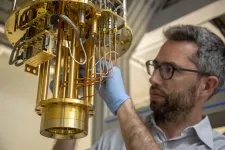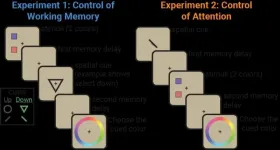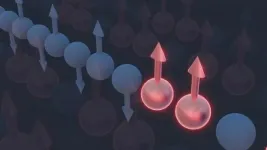Study shows promise of quantum computing using factory-made silicon chips
A single qubit on a standard silicon transistor chip has been successfully demonstrated as "quantum capable" in a new study by the UCL spinout Quantum Motion, led by researchers at UCL and Oxford University.
2021-03-31
(Press-News.org) The qubit is the building block of quantum computing, analogous to the bit in classical computers. To perform error-free calculations, quantum computers of the future are likely to need at least millions of qubits. The latest study, published in the journal PRX Quantum, suggests that these computers could be made with industrial-grade silicon chips using existing manufacturing processes, instead of adopting new manufacturing processes or even newly discovered particles.
For the study, researchers were able to isolate and measure the quantum state of a single electron (the qubit) in a silicon transistor manufactured using a 'CMOS' technology similar to that used to make chips in computer processors.
Furthermore, the spin of the electron was found to remain stable for a period of up to nine seconds. The next step is to use a similar manufacturing technology to show how an array of qubits can interact to perform quantum logic operations.
Professor John Morton (London Centre for Nanotechnology at UCL), co-founder of Quantum Motion, said: "We're hacking the process of creating qubits, so the same kind of technology that makes the chip in a smartphone can be used to build quantum computers.
"It has taken 70 years for transistor development to reach where we are today in computing and we can't spend another 70 years trying to invent new manufacturing processes to build quantum computers. We need millions of qubits and an ultra-scalable architecture for building them, our discovery gives us a blueprint to shortcut our way to industrial scale quantum chip production."
The experiments were performed by PhD student Virginia Ciriano Tejel (London Centre for Nanotechnology at UCL) and colleagues working in a low-temperature laboratory. During operation, the chips are kept in a refrigerated state, cooled to a fraction of a degree above absolute zero (?273 degrees Celsius).
Ms Ciriano Tejel said: "Every physics student learns in textbooks that electrons behave like tiny magnets with weird quantum properties, but nothing prepares you for the feeling of wonder in the lab, being able to watch this 'spin' of a single electron with your own eyes, sometimes pointing up, sometimes down. It's thrilling to be a scientist trying to understand the world and at the same time be part of the development of quantum computers."
A quantum computer harnesses laws of physics that are normally seen only at the atomic and subatomic level (for instance, that particles can be in two places simultaneously). Quantum computers could be more powerful than today's super computers and capable of performing complex calculations that are otherwise practically impossible.
While the applications of quantum computing differ from traditional computers, they will enable us to be more accurate and faster in hugely challenging areas such as drug development and tackling climate change, as well as more everyday problems that have huge numbers of variables - just as in nature - such as transport and logistics.
INFORMATION:
[Attachments] See images for this press release:

ELSE PRESS RELEASES FROM THIS DATE:
2021-03-31
Neuroscientists agree that a person's brain is constantly changing, rewiring itself and adapting to environmental stimuli. This is how humans learn new things and create memories. This adaptability and malleability is called plasticity. "Physicians have long suspected that remodeling processes also take place in humans at the contact points between nerve cells, i.e. directly at the synapses. Until now, however, such a coordinated adaptation of structure and function could only be demonstrated in animal experiments," says Prof. Dr. Andreas Vlachos from the Institute of Anatomy and Cell Biology at the University of Freiburg. But now Vlachos, together with Prof. Dr. Jürgen Beck, head of the Department of Neurosurgery at the University Medical Center Freiburg, has provided experimental evidence ...
2021-03-31
Astronomers have detected X-rays from Uranus for the first time, using NASA's Chandra X-ray Observatory. This result may help scientists learn more about this enigmatic ice giant planet in our solar system.
Uranus is the seventh planet from the Sun and has two sets of rings around its equator. The planet, which has four times the diameter of Earth, rotates on its side, making it different from all other planets in the solar system. Since Voyager 2 was the only spacecraft to ever fly by Uranus, astronomers currently rely on telescopes much closer to Earth, like Chandra and the Hubble Space Telescope, to learn about this distant and cold planet that is made up almost entirely of hydrogen and helium.
In the new study, researchers used Chandra observations ...
2021-03-31
In 1890, psychologist William James described attention as the spotlight we shine not only on the world around us, but also on the contents of our minds. Most cognitive scientists since then have drawn a sharp distinction between what James termed "sensorial attention" and "intellectual attention," now usually called "attention" and "working memory," but James saw them as two varieties of the same mental process.
New research by Princeton neuroscientists suggests that James was on to something, finding that attention to the outside world and attention to our own thoughts are actually two sides of the same neural coin. What's more, they have observed the coin as it flips inside the brain.
A paper published in Nature on March 31 by END ...
2021-03-31
Using complementary computing calculations and neutron scattering techniques, researchers from the Department of Energy's Oak Ridge and Lawrence Berkeley national laboratories and the University of California, Berkeley, discovered the existence of an elusive type of spin dynamics in a quantum mechanical system.
The team successfully simulated and measured how magnetic particles called spins can exhibit a type of motion known as Kardar-Parisi-Zhang, or KPZ, in solid materials at various temperatures. Until now, scientists had not found evidence of this particular phenomenon outside of soft matter ...
2021-03-31
WASHINGTON (March 31, 2021) -- In 2019, Blacks, Latinos and Native Americans were severely underrepresented in the health care workforce, a trend that shows limited signs of improvement, according to a study published today by George Washington University researchers.
"Our findings suggest that Blacks, Latinos and other people of color have been left behind when it comes to the health professions," Edward Salsberg, senior research scientist and co-director of the Health Workforce Diversity Tracker project at the GW Fitzhugh Mullan Institute for Health Workforce Equity, said. The Fitzhugh Mullan Institute ...
2021-03-31
An invasive exotic species is one deliberately or unwittingly introduced by humans into a new habitat, where it becomes an environmental menace. In addition to the loss of biodiversity and other ecological impacts resulting from its presence, an invasive species can lead to economic losses in certain sectors, including agriculture, tourism, and public health. Though biological invasion is the second leading cause of species extinction, decision makers and the general public are still largely unaware of the issue.
After five years of study, the international research team* directed by scientists from the Écologie, Systématique et Évolution (CNRS ...
2021-03-31
Comorbidities such as heart disease, respiratory disease, renal disease and cancer lead to an increased risk of death from Covid-19 according to new research from the University of East Anglia (UEA) and the Norfolk and Norwich University Hospital (NNUH).
At the start of the pandemic, there was concern that specific medications for high blood pressure could be linked with worse outcomes for Covid-19 patients.
Previous research from the UEA team showed this wasn't the case and that medications for high blood pressure could, in fact, improve Covid-19 survival rates and reduce the severity of infection.
New findings, published today in the Journal of the American Medical Association (JAMA) Network Open, additionally show that it is comorbidities such as heart disease, respiratory ...
2021-03-31
Mount Sinai researchers have identified genetic and cellular mechanisms of Crohn's disease, providing new insights for future treatments that could offer a tailored approach to patients with the chronic inflammatory disease, according to a study published in END ...
2021-03-31
CAMBRIDGE, MA -- When someone is sick, it's natural to want to stay as far from them as possible. It turns out this is also true for mice, according to an MIT study that also identified the brain circuit responsible for this distancing behavior.
In a study that explores how otherwise powerful instincts can be overridden in some situations, researchers from MIT's Picower Institute for Learning and Memory found that when male mice encountered a female mouse showing signs of illness, the males interacted very little with the females and made no attempts to mate with them as they normally would. The researchers also showed that this behavior is controlled by a circuit in the amygdala, which detects distinctive odors from sick animals and triggers a warning signal ...
2021-03-31
NEW YORK, NY (March 31, 2021)--A shift in the definition of high blood pressure may help identify more women who are at risk of developing life-threatening complications during pregnancy and delivery, suggests a new study from Columbia University Vagelos College of Physicians and Surgeons.
Under the stricter definition, more than 50,000 additional women each year in the United States could become eligible for treatment with aspirin in pregnancy, which lowers the risk of developing preeclampsia, a sudden increase in blood pressure that can lead to stroke, seizures, hemorrhage, and death.
The ...
LAST 30 PRESS RELEASES:
[Press-News.org] Study shows promise of quantum computing using factory-made silicon chips
A single qubit on a standard silicon transistor chip has been successfully demonstrated as "quantum capable" in a new study by the UCL spinout Quantum Motion, led by researchers at UCL and Oxford University.




